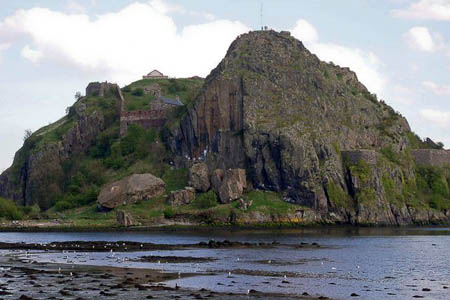An ancient lump of volcanic rock that has the hardest traditional climbing route in Britain is at the centre of a row over plans to clean it of graffiti.
Historic Scotland wants to remove the various scrawls from Dumbarton Rock and its nearby boulders.
But the Mountaineering Council of Scotland said it is worried any such work could damage holds on bouldering and climbing routes.
The rock, on the north bank of the Clyde, was the scene in 2006 of Dave MacLeod’s first ascent of Rhapsody, rated E11.
The MCofS said: “The MCofS regards the area as providing the country’s finest bouldering venue, with a long history in which Scotland’s best climbers have achieved some of the hardest and most challenging boulder problems in the UK, if not the world.
“The main crag above the boulders has some of Scotland’s hardest traditional climbs including the first ever E8 in the UK, which was probably the hardest climb in the world at the time, and the first ever E11 in the world.”
The council, which has 11,000 members and represents climbers, hillwalkers and mountaineers north of the border, added: “We recently received a number of emails expressing concern that there are plans to clean the boulders of graffiti, with possible implications for boulder problems which clearly could be affected by abrasive treatment.”
Dumbarton Rock is topped by Dumbarton Castle and is in the care of Historic Scotland, the Holyrood Government’s agency for the nation’s historic environment.
The agency told the MCofS: “Following considerable local concern regarding the amount of graffiti and litter that has accumulated in recent years Historic Scotland is in the early stages of scoping out cleaning methods to remove the graffiti from the lower reaches of the rock cliff and boulders on the north-west face of Dumbarton Rock.
“In carrying out this work we have taken the advice of our stone conservation specialists and scientists.
“They have had considerable experience in removing graffiti from softer porous sandstone often delicately carved historic stone using gentle non-chemical methods, with no resultant damage to the stone.
“The dense igneous stone of Dumbarton Rock means that there should be little penetration of the stone matrix by the paint which should help successful paint removal.”
But MCofS chief officer David Gibson said: “We recognise that Historic Scotland has the highest levels of expertise in the restoration of monuments.
“However the nature of some of the holds on the boulders may mean that even minimal abrasion could result in damage which would be irreversible.
“We believe the best solution would be for a MCofS representative and a climber who knows the bouldering problems in the area to be present at a test and to confirm that no damage to the holds would be possible as a result of the planned treatment.”
He added: “I would like to thank those climbers who had the foresight to advise us about the planned removal of graffiti. We will aim to respond to any threat to mountaineers’ interests but are often reliant on local knowledge to bring such matters to our attention.”
And today, another official body entered the argument.
Scottish Natural Heritage, the Scottish Government’s adviser on the outdoors, said the rock is also a site of special scientific interest because of its geology.
“The rock itself, plus outcrops on the western shore, tell a nationally important story of an ancient volcano,” it said.
“To make sure this geology can continue to be studied, some vegetation needs cleared from the north face and graffiti from the west face of the rock itself.
“We began to progress these issues with Historic Scotland, the owner of the rock, over recent years. We also made initial contact with the climbing community, as we recognised that the graffiti removal might affect areas valued by them.
“Graffiti that needs removed to conserve the geology does not include that on the boulders.
“We know that Historic Scotland have been investigating removal of graffiti from the boulders, acting on local concerns about the surroundings of Dumbarton Castle.
“We are also aware that climbers, who have worked to keep the area clean, are concerned that graffiti removal could damage the world-famous bouldering.”
SNH said any work to remove graffiti from Dumbarton Rock or its boulders would need its consent under current laws.
It added: “We firmly believe that the interests of all those using the area responsibly can be accommodated by working together.”
Dave MacLeod’s ascent of Rhapsody was filmed by Paul Diffley and is the subject of Hot Aches Productions’ E11.
The main face has almost 50 climbing routes, from Very Difficult upwards, and the boulders have more than 200 named routes.


Julius Zsako
08 July 2012Remove the graffiti vandalism or risk inviting even more graffiti crime. As documented at www.DefacingAmerica.com, graffiti attracts more of the same.
craig britton
09 July 2012Living in southern california I have seen lots of graffiti anf various removval techniqies used on boulder problems. Painting over it with paint or a mixture of sand and rock colored paint is the worst method and makes problems slicker and causes the underlying rock to chip or erode faster. Chemical removal of the tagging weakens sandstore, limestone and poor quality granitics. Chemicals seem ok on fine grained. Granites, just leaving a pattern that is visible when the rock is wet. Wire brushing can erode the rock and either make it slicker or rougher depending on the rock type and quality. For marking soluable in rubbing alcohol a toothbrush and rag clean up the rock with no apparant damage and maybe a trace of paint left. Sandblasting is excellent for rock that has texture everywhere but might make routes on slick rock easier.( At least for a few ascents)